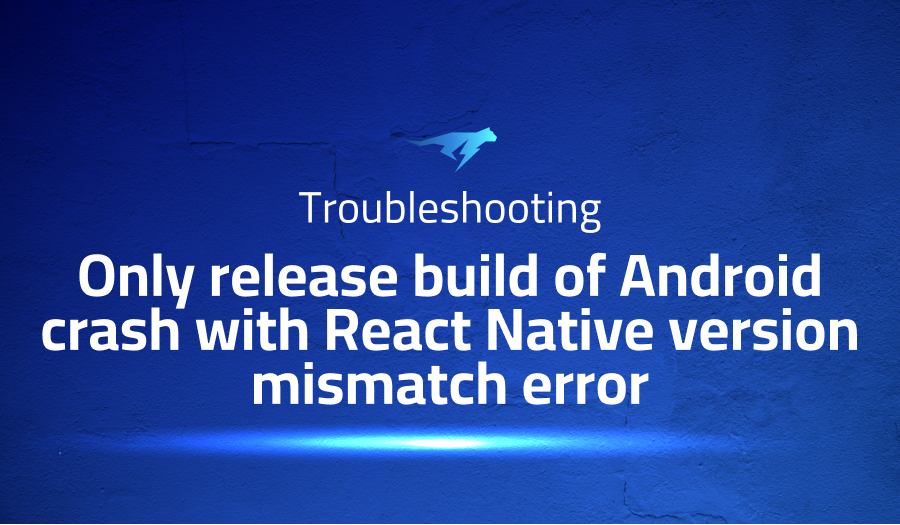

Only release build of Android crash with React Native version mismatch error
Explanation of the problem
The person has updated the iOS version of React Native to 0.63.3 and merged the Android version with React Native version 0.59.8. They manually changed the Android files using an upgrade helper and it worked fine with iOS debug build, release build, and Android debug build. But the Android release build crashed with a React Native version mismatch error. They tried to run the app on Android using a command, but it did not work.
Troubleshooting with the Lightrun Developer Observability Platform
Getting a sense of what’s actually happening inside a live application is a frustrating experience, one that relies mostly on querying and observing whatever logs were written during development.
Lightrun is a Developer Observability Platform, allowing developers to add telemetry to live applications in real-time, on-demand, and right from the IDE.
- Instantly add logs to, set metrics in, and take snapshots of live applications
- Insights delivered straight to your IDE or CLI
- Works where you do: dev, QA, staging, CI/CD, and production
Start for free today
Problem solution for Only release build of Android crash with React Native version mismatch error
The question asked was about how to make a simple game in Java. Several helpful answers were provided. One suggestion was to use a Java game development library called LibGDX, which can simplify game development by providing pre-built game components such as graphics and sound. Another suggestion was to use JavaFX, which is a Java library for creating user interfaces. JavaFX can be used to create a game interface with buttons, labels, and other user interface components.
A third suggestion was to use Java’s built-in graphics libraries, such as AWT or Swing, to create the game graphics. These libraries allow developers to create custom graphics for their games, including images, animations, and visual effects. It was also suggested to use a game loop to handle game logic and update the game state. A game loop is a programming construct that continually updates the game state and redraws the game screen.
In conclusion, creating a simple game in Java can be achieved in various ways. Developers can use libraries such as LibGDX or JavaFX to simplify game development and create user interfaces. Alternatively, they can use Java’s built-in graphics libraries to create custom game graphics and implement a game loop to handle game logic and update the game state. By understanding these basic concepts, developers can start creating their own games in Java.
Other popular problems with React
Problem: Virtual DOM performance issues
One of the most common problems with React is related to performance issues with the virtual DOM. The virtual DOM is a mechanism that React uses to update the view in response to changes in the underlying data. When the state of a component changes, React will first update the virtual DOM, and then update the actual DOM. This process can be slow, particularly if the component has a large number of child elements.
Solution:
To solve this problem, developers can use techniques such as shouldComponentUpdate, which allows components to control when they should re-render, or use the React.memo higher-order component, which only re-renders a component when its props change. Additionally, developers can use the React DevTools extension to identify and optimize components that are causing performance bottlenecks.
Problem: Managing state and props
Another common problem with React is related to managing state and props. React components can have both state and props, which are used to store and pass data between components. However, when a large number of components need to share and update data, it can become difficult to manage and maintain the flow of data.
Solution:
To solve this problem, developers can use a centralized state management library such as Redux or MobX. These libraries allow developers to store all of the application’s state in a single place, and provide a mechanism for updating and sharing that state across all components. Additionally, developers can use the useContext and useReducer hooks to manage state within a component tree.
Problem: Handling Forms
React forms can also be a source of pain for developers, as they require a lot of boilerplate code to handle changes and validation. Forms can be tricky to handle because they often involve multiple inputs, which need to be controlled and updated correctly.
Solution:
To solve this problem, developers can use libraries such as Formik and react-hook-form to handle forms in React. These libraries provide simple APIs for controlling form inputs and handling validation. Additionally, developers can use the useState and useEffect hooks to handle form input changes and validation manually.
A brief introduction to React
React is a JavaScript library for building user interfaces. It was developed by Facebook and is now maintained by a community of developers. React allows developers to build reusable UI components, which can be composed to create complex user interfaces. React uses a virtual DOM (Document Object Model) to improve performance by limiting the amount of changes that need to be made to the actual DOM. The virtual DOM is a lightweight representation of the actual DOM and it allows React to compare the current state of the virtual DOM with the previous state, and make only the necessary changes to the actual DOM.
React follows a component-based architecture, where the user interface is broken down into small, self-contained components that can be easily reused and composed to create more complex UI. React components can have both state and props, which are used to store and pass data between components. React also provides a mechanism for handling events, such as user clicks, through the use of event handlers. React also provides a set of lifecycle methods that developers can use to control when a component is created, updated, and destroyed. This allows developers to control the behavior of their components and optimize performance.
Most popular use cases for React
- Building reusable UI components React allows developers to build reusable UI components that can be composed to create complex user interfaces. Each component is self-contained and can manage its own state and props. This allows developers to easily reuse and maintain their code.
- Dynamic User Interfaces React uses a virtual DOM to improve performance by limiting the amount of changes that need to be made to the actual DOM. This allows developers to build dynamic user interfaces that can efficiently update in response to changes in the underlying data.
- Building complex web applications React can be used to build complex web applications that require efficient updating of dynamic data. React also provides a set of lifecycle methods that developers can use to control when a component is created, updated, and destroyed. This allows developers to control the behavior of their components and optimize performance.
class Counter extends React.Component {
constructor(props) {
super(props);
this.state = { count: 0 };
}
handleClick = () => {
this.setState({ count: this.state.count + 1 });
}
render() {
return (
<div>
<p>Count: {this.state.count}</p>
<button onClick={this.handleClick}>
Increment
</button>
</div>
);
}
}
It’s Really not that Complicated.
You can actually understand what’s going on inside your live applications.




